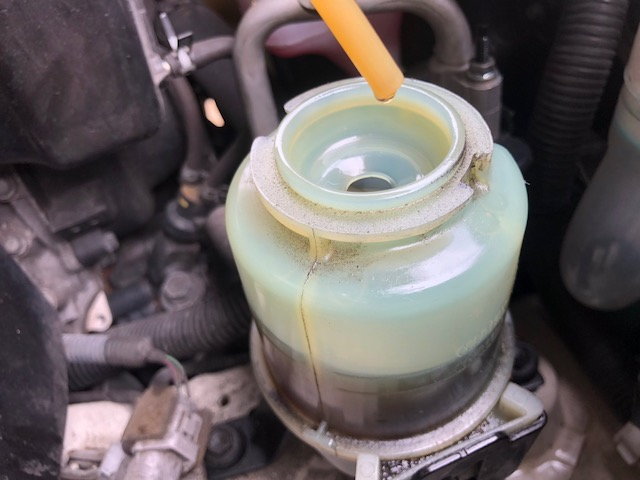What Color is Power Steering Fluid
Power steering fluid is typically light amber, red, or pink in color. The color indicates the fluid’s condition.
With its vibrant hue, power steering fluid is easy to identify under the hood of a vehicle. This hydraulic fluid assists in steering mechanisms by reducing the effort needed to turn the wheels. Ensuring the power steering fluid is at the correct level and in good condition is essential for optimal vehicle performance and safety.
Regularly inspecting the color and level of the fluid can help detect any potential issues early on. It is recommended to consult the vehicle’s manual for specific guidelines on checking and changing power steering fluid.

Credit: www.clublexus.com
The Basics Of Power Steering Fluid
Power steering fluid is essential for the proper functioning of a vehicle’s power steering system. Understanding the basics of power steering fluid, including its color and purpose, is important for maintaining your vehicle and ensuring smooth steering performance.
What Is Power Steering Fluid?
Power steering fluid is a specialized hydraulic fluid that is designed to transmit power in the power steering system of a vehicle. It acts as a crucial component in providing the necessary hydraulic pressure to assist in steering, making it easier for the driver to turn the steering wheel.
The Purpose Of Power Steering Fluid
The primary purpose of power steering fluid is to lubricate and transmit power within the power steering system. It helps to reduce the effort required to turn the steering wheel, especially at lower speeds or when the vehicle is stationary. Power steering fluid also plays a crucial role in maintaining the components of the power steering system by providing lubrication and preventing corrosion.
Identifying Power Steering Fluid Color
The color of power steering fluid can vary, but it is commonly red or amber. Checking the color can help identify if the fluid needs to be replaced or if there is an issue with the system.
Identifying Power Steering Fluid Color Common Power Steering Fluid Colors What Color is Power Steering Fluid? Proper inspection is crucial. What Color Should Power Steering Fluid Be? Yellow to light brown is ideal. Identifying Power Steering Fluid color is critical for vehicle maintenance. Common Power Steering Fluid Colors: Red, Pink, Brown, or clear. What Color is Power Steering Fluid? Red is most common. Inspecting regularly helps maintain optimal performance. Check color to ensure the health of your power steering system. What Color Should Power Steering Fluid Be? Ideally, yellow to light brown.Significance Of Different Power Steering Fluid Colors
Power steering fluid comes in different colors, each indicating certain properties and characteristics. Understanding the significance of different power steering fluid colors helps in identifying potential issues and ensuring optimal performance of your vehicle.
Red Power Steering Fluid
- Common color for most power steering fluids
- Often signifies ATF-based fluid
- Indicates the presence of additives for enhanced lubrication
Clear Or Amber Power Steering Fluid
- Typically colorless or light amber in hue
- May indicate synthetic or mineral oil-based fluid
- Clear color suggests freshness and cleanliness
Pink Or Brown Power Steering Fluid
- Can be a result of fluid contamination
- Pink color may be due to water intrusion
- Brown color might signal oxidation or dirt accumulation
Determining Power Steering Fluid Issues
Determining power steering fluid issues is crucial to maintain the smooth functioning of your vehicle. By understanding the different indicators, such as color changes, you can effectively identify potential problems and address them before they escalate.
Color Changes As An Indicator Of Problems
Power steering fluid typically has a reddish or light brown color. A change in the color of the power steering fluid can be a sign of underlying issues. If the fluid turns dark or black, it could indicate contamination by dirt or debris, which may lead to component wear and potential damage. Similarly, a milky or foamy appearance might suggest water or air has entered the system, compromising its efficiency.
Other Factors To Consider
While color is a significant indicator, there are other factors to consider when assessing power steering fluid issues. These include consistency, smell, and the presence of debris within the fluid. Additionally, an abnormal noise when steering or difficulty in turning the wheel could also be indications of potential power steering fluid problems.
Maintaining And Changing Power Steering Fluid
Introductory paragraphMaintaining and Changing Power Steering Fluid is an important aspect of car maintenance that ensures the smooth functioning of the power steering system. Power steering fluid helps in reducing the effort required to steer the vehicle and also provides lubrication to the components of the system. In this section, we will discuss how to check the power steering fluid level, when to change the fluid, and how to safely perform the fluid change.
H3 Heading: Checking Power Steering Fluid LevelChecking Power Steering Fluid Level
The power steering fluid level should be checked regularly to ensure that it is at the optimum level. Follow these steps to check the power steering fluid level:
- Park the vehicle on a level surface and turn off the engine. Locate the power steering fluid reservoir.
- Remove the cap of the reservoir and wipe the dipstick clean with a cloth.
- Insert the dipstick back into the reservoir and then remove it again.
- Check the fluid level indicated by the markings on the dipstick. If the fluid level is below the “MIN” mark, it needs to be topped up.
- If topping up is required, use the recommended power steering fluid and slowly pour it into the reservoir until it reaches the “MAX” mark.
- Securely replace the cap of the reservoir and ensure it is tightly sealed.
When To Change Power Steering Fluid
Changing the power steering fluid is essential for maintaining the effectiveness of the power steering system. It is recommended to check the manufacturer’s guidelines for the specific interval at which the fluid should be changed. However, there are certain signs that indicate the need for a power steering fluid change:
- If the power steering fluid appears dirty or has a burnt smell, it is advisable to change it.
- When there is a noticeable decrease in the performance of the power steering system, such as difficulty in turning the wheels or a squealing noise, it may be a sign that the fluid needs to be replaced.
- In case of any leaks or damage to the power steering system components, it is necessary to change the fluid.
How To Safely Change Power Steering Fluid
Changing the power steering fluid can be done following these steps:
- Ensure that the vehicle is parked on a level surface and the engine is turned off.
- Locate the power steering fluid reservoir and clean the area around it.
- Remove the cap and use a fluid pump or siphon to extract the old fluid from the reservoir.
- Dispose of the old fluid in accordance with local regulations.
- Refill the reservoir with the recommended power steering fluid.
- Start the engine and turn the steering wheel from lock to lock several times to allow the new fluid to circulate through the system.
- Check the fluid level once more and top up if necessary to ensure it is at the correct level.
- Securely replace the cap of the reservoir.

Credit: www.reddit.com

Credit: tracerproducts.com
Frequently Asked Questions On What Color Is Power Steering Fluid
What Color Should Power Steering Fluid Be?
Power steering fluid should be red or pink in color. This indicates the fluid is in good condition. If the color is brown or black, it may be contaminated or have worn out, and it’s best to have it checked by a professional.
What Color Is A Power Steering Leak?
A power steering leak can be red, pink, or brown in color due to the presence of transmission fluid.
What Does Bad Power Steering Fluid Look Like?
Bad power steering fluid appears dark and thick, with a burnt smell. It may contain debris or metal shavings.
Why Is My Power Steering Fluid Brown And Milky?
The brown and milky power steering fluid indicates water contamination, possibly caused by a leaking radiator or internal seal. It can lead to system damage, so it’s crucial to flush and replace the fluid as soon as possible. Consult a mechanic for further diagnostics and repairs.
What Color Is Power Steering Fluid?
Power steering fluid is typically red or amber in color, but it can also be clear or pink.
How Do I Know If My Power Steering Fluid Is Low?
You can check the power steering fluid level by locating the reservoir and checking the dipstick or the sight glass.
Can I Mix Different Colors Of Power Steering Fluid?
It is not recommended to mix different colors of power steering fluid as it can lead to potential damage to the system.
Conclusion
The color of power steering fluid can vary, but typically it is red or green. It is crucial to regularly check the color and condition of your power steering fluid to ensure your vehicle’s optimal performance and safety. Proper maintenance of power steering fluid is essential for the longevity of your car’s steering system.
Keep an eye on the color and consult your car’s manual for any discrepancies. Regular inspection and timely replacement of power steering fluid are key to a well-functioning vehicle.

